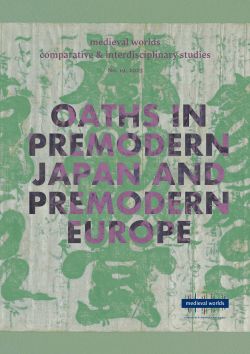Megan Gilbert
S. 65 - 85
doi:
10.1553/medievalworlds_no19_2023s65
Verlag der Österreichischen Akademie der Wissenschaften
doi:
10.1553/medievalworlds_no19_2023s65
Abstract:
This article examines the role of written oaths in preventing and resolving disputes in central Japan during the fifteenth century. It examines the circumstances in which probatory oaths were used and the characteristics that made them effective. Probatory written oaths, which established facts of past and present rather than making promises for the future, both depended upon and were constitutive of community cohesion. They were public performances that could accommodate a broad array of distinctions in social status, from imperial prince to temple servant. Written oaths were united by one shared danger – increased vulnerability to the sanction of deities. Conversely, different status groups had access to different methods, such as the prince writing on a talisman or the servant pulling a stone from boiling water, to lend weight to their oaths, which both humans and gods could then use equivalently. The disparities in effort helped to compensate for status differentials among disputants and witnesses. After establishing the functioning of probatory written oaths in Japan – a function treated more sparsely than promissory oaths in the existing literature – this article analyzes the use of such oaths in resolving one type of dispute – accusations of adultery. Adultery was treated with increased severity as the century progressed. This example demonstrates how written oaths were used to investigate, proclaim innocence, and navigate status in public. Written oaths created factual consensus in disputes but left room to negotiate outcomes. Fifteenth-century Japan produced a rich array of records that reveal the negotiations that took place behind official action, particularly diary-chronicles – individuals’ daily records (diary) that were intended to guide posterity in official actions (chronicles) – as well as meeting notes from the governing council of a major temple. Such records make it possible to capture some of the experience of using written oaths.
Oaths, ordeals, kishōmon, medieval Japan, Muromachi era, ritual and writing, construction of community, juridical proof
Published Online:
2023/11/30 08:56:52
Object Identifier:
0xc1aa5576 0x003ea4f9
Rights:https://creativecommons.org/licenses/by-nc-nd/4.0/
"medieval worlds" provides a forum for comparative, interdisciplinary and transcultural studies of the Middle Ages. Its aim is to overcome disciplinary boundaries, regional limits and national research traditions in Medieval Studies, to open up new spaces for discussion, and to help developing global perspectives. We focus on the period from c. 400 to 1500 CE but do not stick to rigid periodization.
medieval worlds is open to submissions of broadly comparative studies and matters of global interest, whether in single articles, companion papers, smaller clusters, or special issues on a subject of global/comparative history. We particularly invite studies of wide-ranging connectivity or comparison between different world regions.
Apart from research articles, medieval worlds publishes ongoing debates and project and conference reports on comparative medieval research.
In this volume, guest editors Philippe Buc and Thomas D. Conlan use oaths as the pivotal point for their comparative thematic section. Focusing on the differences and similarities between Japanese and European oath-taking and oath-breaking practices during the medieval period, on terminology and on chronology, Philippe Buc provides an introduction that contextualises the studies in this collection. For Japan, Yoshikawa S. and T.D. Conlan give insights into the development of the written oath (kishōmon) from its predecessors and origins in the third to sixth centuries to the sixteenth century, M. Gilbert and Horikawa Y. provide case studies of kishōmon in the heyday of its use. For Western Europe, S. Esders outlines the development of oaths from Late Antiquity to the tenth century under Christian doctrinal influence. In three case studies, H. Reimitz, H. Débax and O. Richard illustrate the use of oaths in the Early, High and Late Middle Ages.
In our individual articles section, E. Worrall, R. Kramer and T. Grant offer a new edition and commented translation of an Icelandic fragment of the Nikuláss saga erkibiskups, the Saga of Bishop Nicholas.




 Home
Home Print
Print
 References
References
 Share
Share
